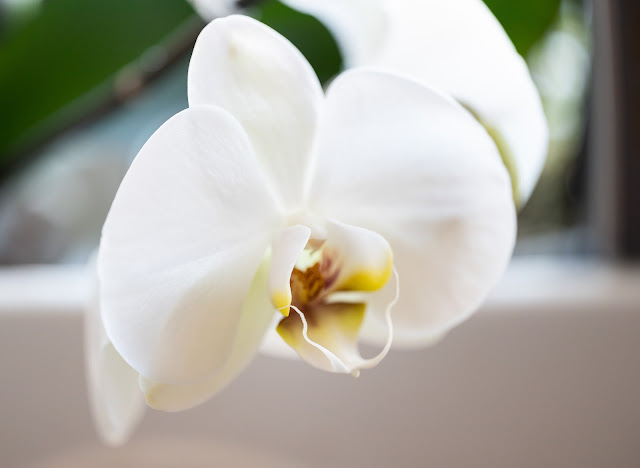A Study in Macros
 |
| 105mm MC, f/5, 1/60, ISO220 |
Admittedly, I am a complete newbie in macro photography. Until I go into the really small things, let me try the accessible stuff and share my experiences. For a start, here is an orchid for you. It is currently blossoming in our home.
The image above has been taken with my 105mm MC. This is an expensive lens which is a bit under-challenged by that motive. Moreover, the composition is not attractive. Furthermore, I made a simple error and underexposed. This image needs to be exposed for the center of the flower. By default, the camera will expose for the white petals and render them and grayish. I like the sharpness of the yellow-white pattern in the center, however.
 |
| 105mm MC, f/3.2, 1/125, ISO320 |
Probably, a composition like this is more interesting, because it leads the eye to the fine fingers of the flower, an interesting detail. Due to the small DOF, the rest of the flower will be blurry.
Next, I tried the 50mm f/1.8 with a small Meike ring. This time, the exposure is not fixed.
 |
| 50mm, f/4, 1/60, ISO280 |
Although it is very similar, the focussing was different. It is not easy to get this right with a 50mm and a macro ring. But the image shows that you can get good results without the expensive 105mm MC. The situation may change when a closer focus is required and thus a longer macro extension. More on this in a later posting when I have collected more experience.
But there is also a far easier alternative for micro shots. Simply use your zoom lens on the long end. In my case, that is the 24-200mm f/4-6.3. The lens can focus quite closely and reach about 0.3 magnification. For real macros this is not sufficient. But flowers work quite well. The sharpness is not up to par with the prime lenses either, but sufficiently good.
 |
| Nikkor 24-200mm, 170mm, f/6.3, 1/60, ISO400 |
Why not try a true macro with this flower? Below is my first attempt with a single focus point on the colorful pattern in the center at f/8. The sharpness is not the point here. Orchids are soft structures and do not preset sharp textures.
I also tried some focus stacking. The result is somewhat disappointing. The reason is that Photoshop cannot get the image blended. It even displays an error message hinting the problem. Now, we should be aware that the distances vary greatly when we start at the two hairs in front and go all the way to the back. Probably, no software can handle this without artifacts.


Comments
Post a Comment